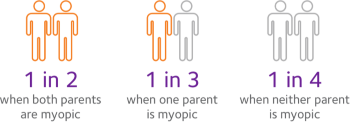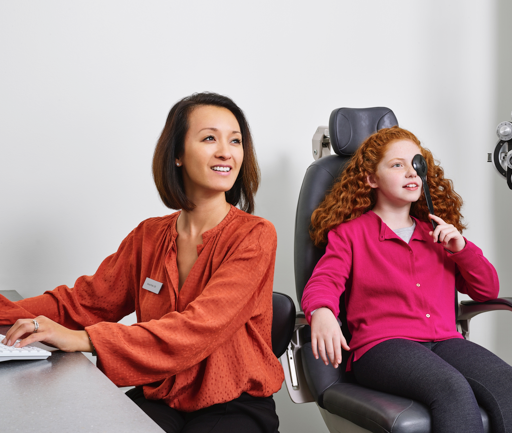Myopia, commonly known as nearsightedness, is more than a vision inconvenience.
MiSight® 1 day contact lenses are the first and only FDA-approved* soft contact lenses proven to slow myopia progression in children, aged 8-12 at the initiation of treatment. 1**
Myopia Assessment Tool
Find out what to do if your child is myopic.
Take our short quiz to understand more about myopia and your child.
Take the quiz

Myopia is more commonly referred to as nearsightedness, or the inability to see objects clearly at a distance
If you had nearsightedness, also known as myopia, when you were a child, you know that it’s progressed and worsened as you’ve gotten older. Worsening myopia is not just a vision inconvenience, it may contribute to more severe eye health complications and sight-threatening conditions later in life.2 3
What causes myopia?
Myopia is on the rise - in its frequency and severity.4 The reason for its escalation has been linked to two factors.
Genetics
Family history plays a role in your child's risk of myopia. The likelihood of children developing increases if their parents are myopic. 5
The odds of a child becoming myopic is approximately: 5Lifestyle
Research shows, especially now as digital technology has become beneficial to educating the next generation of future leaders, that modern lifestyles may influence the development of myopia. 6 8 9




Together, we can help manage myopia
More than just vision correction, a myopia management program can help keep your child's future brilliant. The first step is scheduling a comprehensive eye exam so your child's Eye Care Practitioner can recommend appropriate treatment. The next step is learning more about CooperVision's myopia management program, Brilliant FuturesTM with MiSight® 1 day.


Sign up for updates
Register now to receive more information about the Brilliant FuturesTM Myopia Management Program.
Indications and Important Safety Information:
RX Only
Results May Vary.
ATTENTION: Reference the Patient Information Booklet for a complete listing of Indications and Important Safety Information. Indication: MiSight® 1 day (omafilcon A) soft (hydrophilic) contact lenses for daily wear are indicated for the correction of myopic ametropia and for slowing the progression of myopia in children with non-diseased eyes, who at the initiation of treatment are 8-12 years of age and have a refraction of -0.75 to -4.00 diopters(spherical equivalent) with ≤ 0.75 diopters of astigmatism. The lens is to be discarded after each removal. Warnings: Problems with contact lenses could result in serious injury to the eye. Do not expose contact lenses to water while wearing them. Under certain circumstances MiSight® lenses optical design can cause reduced image contrast/ghosting/halo/glare in some patients that may cause difficulties with certain visually-demanding tasks. Precautions: Daily wear single use only. Patient should always dispose when lenses are removed. No overnight wear. Patients should exercise extra care if performing potentially hazardous activities. Adverse events: Including but not limited to infection/inflammation/ulceration/abrasion of the cornea, other parts of the eye or eyelids. Some of these adverse reactions can cause permanent or temporary loss of vision. If you notice any of the stated in your child, immediately have your child remove the lenses and contact your eye care professional.
** Compared to a single vision 1 day lens over a 3 year period.
References:
- 1. CooperVision data on file 2019. Chamberlain P, Logan N, Jones D, Gonzalez-Meijome J, Saw S-M, Young G. Clinical evaluation of a dual-focus myopia control 1 day soft contact lens: 3-year results (2016 American Academy of Optometry Annual Meeting) and 5-year results (2019 BCLA Clinical Conference & Exhibition).
- 2. Xu L, Wang Y, Wang S, Wang Y Jonas JB. ‘High Myopia and Glaucoma Susceptibility: The Beijing Eye Study. Ophthalmology, 2007;114(2):216-20.
- 3. Flitcroft DI. The complex interactions of retinal, optical, and environmental factors in myopia aetiology Prog Retin Eye Res. 2012;31(6):622-660.
- 4. Holden BA, et al. Global Prevalence of Myopia and High Myopia and Temporal Trends from 2000 through 2050. Ophthalmology. 2016;123(5):1036-42.
- 5. Morgan P. Is Myopia Control the Next Contact Lens Revolution? OPTICIAN 2016
- 6. Gifford P, Gifford, K L. The Future of Myopia Control Contact Lenses. Opt Vis Sci. 2016;93(4):336-43.
- 7. Rose KA, Morgan IG, Ip J, et al. Outdoor Activity Reduces the Prevalence of Myopia in Children. Ophthalmology 2008;115(8):1279-85.
- 8. Wolffsohn JS, Calossi A, Cho P, et al. Global Trends in Myopia Management Attitudes and Strategies in ClinicalPractice. Cont Lens Anterior Eye. 2016;39(2):106-16.
- 9. Chee Wai WONG, M.D. M.C.I. Digital Screen Time During COVID-19 Pandemic: Risk for a Further Myopia Boom?. American Journal of Opthalmology. 2020.07.29
© 2020 Coopervision. | Part of CooperCompanies

